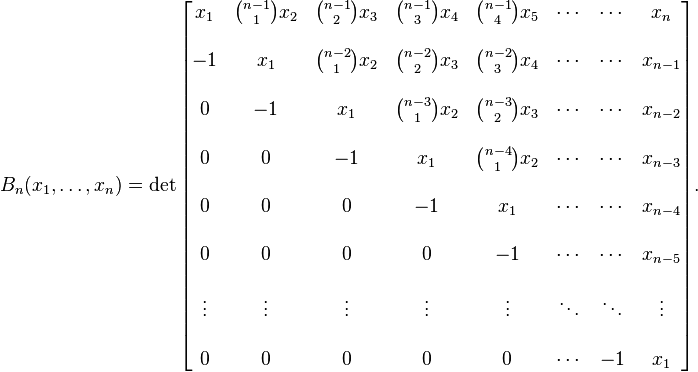Bell polynomials
In combinatorial mathematics, the Bell polynomials, named in honor of Eric Temple Bell, are a triangular array of polynomials given by
where the sum is taken over all sequences j1, j2, j3, ..., jn−k+1 of non-negative integers such that
Complete Bell polynomials
The sum
is sometimes called the nth complete Bell polynomial. In order to contrast them with complete Bell polynomials, the polynomials Bn, k defined above are sometimes called "partial" Bell polynomials.
The complete Bell polynomials satisfy the following identity
Combinatorial meaning
If the integer n is partitioned into a sum in which "1" appears j1 times, "2" appears j2 times, and so on, then the number of partitions of a set of size n that collapse to that partition of the integer n when the members of the set become indistinguishable is the corresponding coefficient in the polynomial.
Examples
For example, we have
because there are
- 6 ways to partition a set of 6 as 5 + 1,
- 15 ways to partition a set of 6 as 4 + 2, and
- 10 ways to partition a set of 6 as 3 + 3.
Similarly,
because there are
- 15 ways to partition a set of 6 as 4 + 1 + 1,
- 60 ways to partition a set of 6 as 3 + 2 + 1, and
- 15 ways to partition a set of 6 as 2 + 2 + 2.
Properties
Stirling numbers and Bell numbers
The value of the Bell polynomial Bn,k(x1,x2,...) when all xs are equal to 1 is a Stirling number of the second kind:
The sum
is the nth Bell number, which is the number of partitions of a set of size n.
Convolution identity
For sequences xn, yn, n = 1, 2, ..., define a sort of convolution by:
 .
.
Note that the bounds of summation are 1 and n − 1, not 0 and n .
Let  be the nth term of the sequence
be the nth term of the sequence
Then
For example, let us compute  . We have
. We have
and thus,
Applications of Bell polynomials
Faà di Bruno's formula
Faà di Bruno's formula may be stated in terms of Bell polynomials as follows:
Similarly, a power-series version of Faà di Bruno's formula may be stated using Bell polynomials as follows. Suppose
Then
In particular, the complete Bell polynomials appear in the exponential of a formal power series:
Moments and cumulants
The sum
is the nth moment of a probability distribution whose first n cumulants are κ1, ..., κn. In other words, the nth moment is the nth complete Bell polynomial evaluated at the first n cumulants.
Representation of polynomial sequences of binomial type
For any sequence a1, a2, a3, ... of scalars, let
Then this polynomial sequence is of binomial type, i.e. it satisfies the binomial identity
for n ≥ 0. In fact we have this result:
- Theorem: All polynomial sequences of binomial type are of this form.
If we let
taking this power series to be purely formal, then for all n,
Software
- Bell polynomials, complete Bell polynomials and generalized Bell polynomials are implemented in Mathematica as BellY, in Maple as BellB, and in Sage as bell_polynomial.
See also
- Bell matrix
- Exponential formula
References
- Eric Temple Bell (1927–1928). "Partition Polynomials". Annals of Mathematics 29 (1/4): 38–46. doi:10.2307/1967979. JSTOR 1967979. MR 1502817.
- Louis Comtet (1974). Advanced Combinatorics: The Art of Finite and Infinite Expansions. Dordrecht, Holland / Boston, U.S.: Reidel Publishing Company.
- Steven Roman. The Umbral Calculus. Dover Publications.
- Vassily G. Voinov, Mikhail S. Nikulin (1994). "On power series, Bell polynomials, Hardy-Ramanujan-Rademacher problem and its statistical applications". Kybernetika 30 (3): 343–358. ISSN 0023-5954.
- Andrews, George E. (1998). The Theory of Partitions. Cambridge Mathematical Library (1st pbk ed.). Cambridge University Press. pp. 204–211. ISBN 0-521-63766-X.
- Silvia Noschese, Paolo E. Ricci (2003). "Differentiation of Multivariable Composite Functions and Bell Polynomials". Journal of Computational Analysis and Applications 5 (3): 333–340. doi:10.1023/A:1023227705558.
- Abbas, Moncef; Bouroubi, Sadek (2005). "On new identities for Bell's polynomial". Disc. Math (293): 5–10. doi:10.1016/j.disc.2004.08.023. MR 2136048.
- Khristo N. Boyadzhiev (2009). "Exponential Polynomials, Stirling Numbers, and Evaluation of Some Gamma Integrals". Abstract and Applied Analysis 2009: Article ID 168672. doi:10.1155/2009/168672. (contains also elementary review of the concept Bell-polynomials)
- V. V. Kruchinin (2011). "Derivation of Bell Polynomials of the Second Kind". arXiv:1104.5065.
- Griffiths, Martin (2012). "Families of sequences from a class of multinomial sums". Journal of Integer Sequences 15. MR 2872465.
























